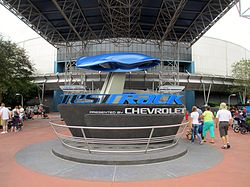This article needs additional citations for verification .(May 2025) |
| Test Track Presented by General Motors | |
|---|---|
  The pavilion logo (top), used since 2019, a throwback to the original pavilion logo used for World of Motion, and the attraction logo (bottom) during the Test Track 2.0 era from 2012 to 2024 | |
 Marquee and entrance to the attraction, pictured in 2014 | |
| Epcot | |
| Area | Future World (1998–2021) World Discovery (2021–present) |
| Coordinates | 28°22′24″N81°32′52″W / 28.373277°N 81.547663°W |
| Status | Operating |
| Cost | $300,000,000 (estimated) [1] |
| Soft opening date | December 19, 1998 December 3, 2012 (2.0) July 20, 2025 (3.0) |
| Opening date | March 17, 1999 December 6, 2012 (2.0) July 22, 2025 (3.0) |
| Closing date | April 15, 2012 (1.0) June 17, 2024 (2.0) |
| Replaced | World of Motion (Future World) |
| Ride statistics | |
| Manufacturer | Dynamic Attractions |
| Designer | |
| Theme |
|
| Music | George Wilkins (1999–2012) [3] Paul Leonard-Morgan (2012–2024) [4] Zain Effendi (2025–present) |
| Speed | 65.1 mph (104.8 km/h) |
| Site area | 150,000 sq ft (14,000 m2) |
| Vehicle type | Slot car |
| Riders per vehicle | 6 |
| Rows | 2 |
| Riders per row | 3 |
| Duration | About 5 minutes |
| Height restriction | 40 in (102 cm) |
| Sponsors |
|
Test Track is a high-speed slot car thrill ride manufactured by Dynamic Attractions [5] located in World Discovery at Epcot, a theme park at the Walt Disney World Resort in Bay Lake, Florida. Designed by Walt Disney Imagineering in partnership with General Motors (GM's Chevrolet marque during its second era), the ride is a simulated excursion through the rigorous testing procedures that General Motors uses to evaluate its concept cars, culminating in a high-speed drive around the exterior of the attraction.
Contents
- History
- Test Track 1.0, Presented by General Motors (March 1999 – April 2012)
- Test Track 2.0, Presented by Chevrolet (December 2012 – June 2024)
- Test Track 3.0, Presented by General Motors (2025–present)
- Ride overview
- 1999–2012
- 2012–2024
- 2025–present
- See also
- References
- Further reading
- External links
The attraction soft-opened to the public, as Test Track 1.0, on December 19, 1998, after a long delay due to problems revealed during testing and to changes in design. As a result, the attraction officially opened on March 17, 1999. Test Track replaced the World of Motion ride, which closed three years earlier in 1996. [6] Originally, guests rode in "test vehicles" in a GM "testing facility" through a series of assessments to illustrate how automobile prototype evaluations were conducted. The highlight of the attraction is a speed trial on a track around the exterior of the building at a top speed of 64.9 miles per hour (104.4 km/h) making it the fastest Disney theme park attraction ever built. [7]
Test Track 1.0 closed for refurbishment on April 15, 2012, and re-opened on December 6 in its second edition, or Test Track 2.0, [8] sponsored by Chevrolet instead of General Motors as a whole. Guests now design their own car in the Chevrolet Design Studio. Then they board a "Sim-Car" and are taken through the "digital" testing ground of the "SimTrack". Throughout the ride, guests see how their designs performed in each test. After the ride, guests can see how their car did overall, film a commercial, race their designs, and have a picture taken with their own virtually designed vehicle with a chosen backdrop in the background. Test Track is located in World Discovery, formerly known as Future World East.
On September 9, 2023, Disney announced that Test Track would be receiving a third retheming inspired by the original World of Motion ride. Test Track 2.0 closed permanently on June 17, 2024 to make way for the ride's third iteration, Test Track 3.0, which soft-opened to the public on July 20, 2025. [9] General Motors returned as the attraction's sponsor instead of their Chevrolet division when the ride reopened on July 22, 2025. [10] The updated attraction showcases new vehicle technology using effects and narration, featuring a House of the Future, a forest drive, and a futuristic projection dome. The high-speed loop remains the highlight, though the "Sim-Car" technology has been completely removed. The ride, entrance plaza, and queue features music composed by Zain Effendi; the EPCOT: Test Track soundtrack was released on Walt Disney Records on August 8, 2025. [11]




